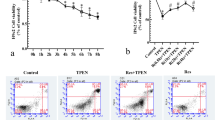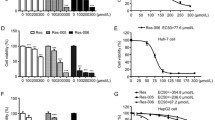Abstract
Resveratrol (RSV), a natural polyphenolic antioxidant, has been considered an anticarcinogenic agent as it triggers tumor cell apoptosis through activation of the mitochondrial pathway. In our study, the effects of RSV on mitochondria, especially on the mitochondrial permeability transition (MPT) process, were investigated by multiple methods. We found that RSV induced a collapse of membrane potential and matrix swelling related to MPT. We further demonstrated that Ca2+ was necessary for this RSV-induced MPT opening. In addition, RSV induced the inner membrane permeabilization to H+ and K+, the depression of respiration and changes in membrane fluidity. The results suggested that RSV-induced MPT was accompanied by mitochondrial dysfunction. But the prohibition on lipid peroxidation and different effects of low- and high-dose RSV on membrane fluidity and respiration showed that the interaction of RSV and the mitochondria could not be the result of a single simple mechanism.







Similar content being viewed by others
References
Adlam VJ, Harrison JC, Porteous CM, James AM, Smith RAJ, Murphy MP, Sammut IA (2005) Targeting an antioxidant to mitochondria decreases cardiac ischemia–reperfusion injury. FASEB J 19(9):1088–1095
Aziz MH, Kumar R, Ahmad N (2003) Cancer chemoprevention by resveratrol: in vitro and in vivo studies and the underlying mechanisms. Int J Oncol 23(1):17–28
Baur JA, Sinclair DA (2006) Therapeutic potential of resveratrol: the in vivo evidence. Nat Rev Drug Discov 5(6):493–506
Baur JA, Pearson KJ, Price NL, Jamieson HA, Lerin C, Kalra A, Prabhu VV, Allard JS, Lopez-Lluch G, Lewis K, Pistell PJ, Poosala S, Becker KG, Boss O, Gwinn D, Wang MY, Ramaswamy S, Fishbein KW, Spencer RG, Lakatta EG, Le Couteur D, Shaw RJ, Navas P, Puigserver P, Ingram DK, de Cabo R, Sinclair DA (2006) Resveratrol improves health and survival of mice on a high-calorie diet. Nature 444(7117):337–342
Biasutto L, Mattarei A, Marotta E, Bradaschia A, Sassi N, Garbisa S, Zoratti M, Paradisi C (2008) Development of mitochondria-targeted derivatives of resveratrol. Bioorg Med Chem Lett 18(20):5594–5597
Brustovetsky N, Dubinsky JM (2000) Limitations of cyclosporin A inhibition of the permeability transition in CNS mitochondria. J Neurosci 20(22):8229–8237
Crompton M (1999) The mitochondrial permeability transition pore and its role in cell death. Biochem J 341:233–249
Dave M, Attur M, Palmer G, Al-Mussawir HE, Kennish L, Patel J, Abramson SB (2008) The antioxidant resveratrol protects against chondrocyte apoptosis via effects on mitochondrial polarization and ATP production. Arthritis Rheum 58(9):2786–2797
Dȩbska G, May R, Kicińska A, Szewczyk A, Elger CE, Kunz WS (2001) Potassium channel openers depolarize hippocampal mitochondria. Brain Res 892(1):42–50
Delmas D, Rebe C, Lacour S, Filomenko R, Athias A, Gambert P, Cherkaoui-Malki M, Jannin B, Dubrez-Daloz L, Latruffe N, Solary E (2003) Resveratrol-induced apoptosis is associated with Fas redistribution in the rafts and the formation of a death-inducing signaling complex in colon cancer cells. J Biol Chem 278(42):41482–41490
Dikalov SI, Li W, Doughan AK, Blanco RR, Zafari AM (2012) Mitochondrial reactive oxygen species and calcium uptake regulate activation of phagocytic NADPH oxidase. Am J Physiol Regul Integr Comp Physiol 302(10):R1134–R1142
Dorrie J, Gerauer H, Wachter Y, Zunino SJ (2001) Resveratrol induces extensive apoptosis by depolarizing mitochondrial membranes and activating caspase-9 in acute lymphoblastic leukemia cells. Cancer Res 61(12):4731–4739
Fernandes MAS, Custodio JBA, Santos MS, Moreno AJM, Vicente JAF (2006) Tetrandrine concentrations not affecting oxidative phosphorylation protect rat liver mitochondria from oxidative stress. Mitochondrion 6(4):176–185
Fernandes MAS, Marques RJF, Vicente JAF, Santos MS, Monteiro P, Moreno AJM, Custodio JBA (2008) Sildenafil citrate concentrations not affecting oxidative phosphorylation depress H2O2 generation by rat heart mitochondria. Mol Cell Biochem 309(1–2):77–85
Fontecave M, Lepoivre M, Elleingand E, Gerez C, Guittet O (1998) Resveratrol, a remarkable inhibitor of ribonucleotide reductase. FEBS Lett 421(3):277–279
Gamble JG, Lehninge Al (1973) Transport of ornithine and citrulline across mitochondrial membrane. J Biol Chem 248(2):610–618
Garcia JJ, Reiter RJ, Ortiz GG, Oh CS, Tang L, Yu BP, Escames G (1998) Melatonin enhances tamoxifen’s ability to prevent the reduction in microsomal membrane fluidity induced by lipid peroxidation. J Membr Biol 162(1):59–65
Gosslau A, Chen M, Ho CT, Chen KY (2005) A methoxy derivative of resveratrol analogue selectively induced activation of the mitochondrial apoptotic pathway in transformed fibroblasts. Br J Cancer 92(3):513–521
Gusman J, Malonne H, Atassi G (2001) A reappraisal of the potential chemopreventive and chemotherapeutic properties of resveratrol. Carcinogenesis 22(8):1111–1117
Jang MS, Cai EN, Udeani GO, Slowing KV, Thomas CF, Beecher CWW, Fong HHS, Farnsworth NR, Kinghorn AD, Mehta RG, Moon RC, Pezzuto JM (1997) Cancer chemopreventive activity of resveratrol, a natural product derived from grapes. Science 275(5297):218–220
Lagouge M, Argmann C, Gerhart-Hines Z, Meziane H, Lerin C, Daussin F, Messadeq N, Milne J, Lambert P, Elliott P, Geny B, Laakso M, Puigserver P, Auwerx J (2006) Resveratrol improves mitochondrial function and protects against metabolic disease by activating SIRT1 and PGC-1 alpha. Cell 127(6):1109–1122
Lakowicz JR (1999) Principles of fluorescence spectroscopy, 2nd edn. Plenum Press, New York
Li JH, Zhang Y, Xiao Q, Tian FF, Liu XR, Li R, Zhao GY, Jiang FL, Liu Y (2011) Mitochondria as target of quantum dots toxicity. J Hazard Mater 194:440–444
Lim HW, Lim HY, Wong KP (2009) Uncoupling of oxidative phosphorylation by curcumin: implication of its cellular mechanism of action. Biochem Biophys Res Commun 389(1):187–192
Ma XD, Tian XM, Huang XX, Yan F, Qiao DF (2007) Resveratrol-induced mitochondrial dysfunction and apoptosis are associated with Ca2+ and mCICR-mediated MPT activation in HepG2 cells. Mol Cell Biochem 302(1–2):99–109
Mahyar-Roemer M, Katsen A, Mestres P, Roemer K (2001) Resveratrol induces colon tumor cell apoptosis independently of p53 and preceded by epithelial differentiation, mitochondrial proliferation and membrane potential collapse. Int J Cancer 94(5):615–622
Monteiro JP, Oliveira PJ, Moreno AJM, Jurado AS (2008) Disruption of hepatic mitochondrial bioenergetics is not a primary mechanism for the toxicity of methoprene: relevance for toxicological assessment. Chemosphere 72(9):1347–1354
Pervaiz S (2001) Resveratrol from the bottle to the bedside? Leuk Lymphoma 40(5–6):491–498
Petrosillo G, Ruggiero FM, Pistolese M, Paradies G (2004) Ca2+-induced reactive oxygen species production promotes cytochrome c release from rat liver mitochondria via mitochondrial permeability transition (MPT)-dependent and MPT-independent mechanisms. J Biol Chem 279(51):53103–53108
Ricchelli F, Gobbo S, Moreno G, Salet C (1999a) Changes of the fluidity of mitochondrial membranes induced by the permeability transition. Biochemistry 38(29):9295–9300
Ricchelli F, Barbato P, Milani M, Gobbo S, Salet C, Moreno G (1999b) Photodynamic action of porphyrin on Ca2+ influx in endoplasmic reticulum: a comparison with mitochondria. Biochem J 338:221–227
Savouret JF, Quesne M (2002) Resveratrol and cancer: a review. Biomed Pharmacother 56(2):84–87
Tinhofer I, Bernhard D, Senfter M, Anether G, Loeffler M, Kroemer G, Kofler R, Csordas A, Greil R (2001) Resveratrol, a tumor-suppressive compound from grapes, induces apoptosis via a novel mitochondrial pathway controlled by Bcl-2. FASEB J 15(9):1613–1615
van Ginkel PR, Darjatmoko SR, Sareen D, Subramanian L, Bhattacharya S, Lindstrom MJ, Albert DM, Polans AS (2008) Resveratrol inhibits uveal melanoma tumor growth via early mitochondrial dysfunction. Investig Ophthalmol Vis Sci 49(4):1299–1306
Xi JK, Wang HH, Mueller RA, Norfleet EA, Xu ZL (2009) Mechanism for resveratrol-induced cardioprotection against reperfusion injury involves glycogen synthase kinase 3 beta and mitochondrial permeability transition pore. Eur J Pharmacol 604(1–3):111–116
Xia T, Jiang CS, Li LJ, Wu CH, Chen Q, Liu SS (2002) A study on permeability transition pore opening and cytochrome c release from mitochondria, induced by caspase-3 in vitro. FEBS Lett 510(1–2):62–66
Yarana C, Sripetchwandee J, Sanit J, Chattipakorn S, Chattipakorn N (2012) Calcium-induced cardiac mitochondrial dysfunction is predominantly mediated by cyclosporine A-dependent mitochondrial permeability transition pore but not mitochondrial calcium uniporter. Arch Med Res 43:333–338
Yousuf S, Atif F, Ahmad M, Hoda N, Ishrat T, Khan B, Islam F (2009) Resveratrol exerts its neuroprotective effect by modulating mitochondrial dysfunctions and associated cell death during cerebral ischemia. Brain Res 1250:242–253
Yu SP (2003) Regulation and critical role of potassium homeostasis in apoptosis. Prog Neurobiol 70(4):363–386
Zamzami N, Marchetti P, Castedo M, Zanin C, Vayssiere JL, Petit PX, Kroemer G (1995) Reduction in mitochondrial potential constitutes an early irreversible step of programmed lymphocyte death in vivo. J Exp Med 181(5):1661–1672
Zhang Y, Li JH, Liu XR, Jiang FL, Tian FF, Liu Y (2011) Spectroscopic and microscopic studies on the mechanisms of mitochondrial toxicity induced by different concentrations of cadmium. J Membr Biol 241(1):39–49
Zhu YS, Xu HB, Huang KX (2002) Mitochondrial permeability transition and cytochrome c release induced by selenite. J Inorg Biochem 90(1–2):43–50
Zini R, Morin C, Bertelli A, Bertelli AAE, Tillement J-P (2002) Resveratrol-induced limitation of dysfunction of mitochondria isolated from rat brain in an anoxia-reoxygenation model. Life Sci 71(26):3091–3108
Acknowledgments
The authors gratefully acknowledge financial support from the National Natural Science Foundation of China (Grants 21077081, 21273065, 21203035, 20921062) and the National Science Foundation for Distinguished Young Scholars of China (Grant 21225313).
Author information
Authors and Affiliations
Corresponding author
Rights and permissions
About this article
Cite this article
Zhang, Y., Tian, F., Xiao, Q. et al. Exploiting the Role of Resveratrol in Rat Mitochondrial Permeability Transition. J Membrane Biol 246, 365–373 (2013). https://doi.org/10.1007/s00232-013-9540-0
Received:
Accepted:
Published:
Issue Date:
DOI: https://doi.org/10.1007/s00232-013-9540-0




